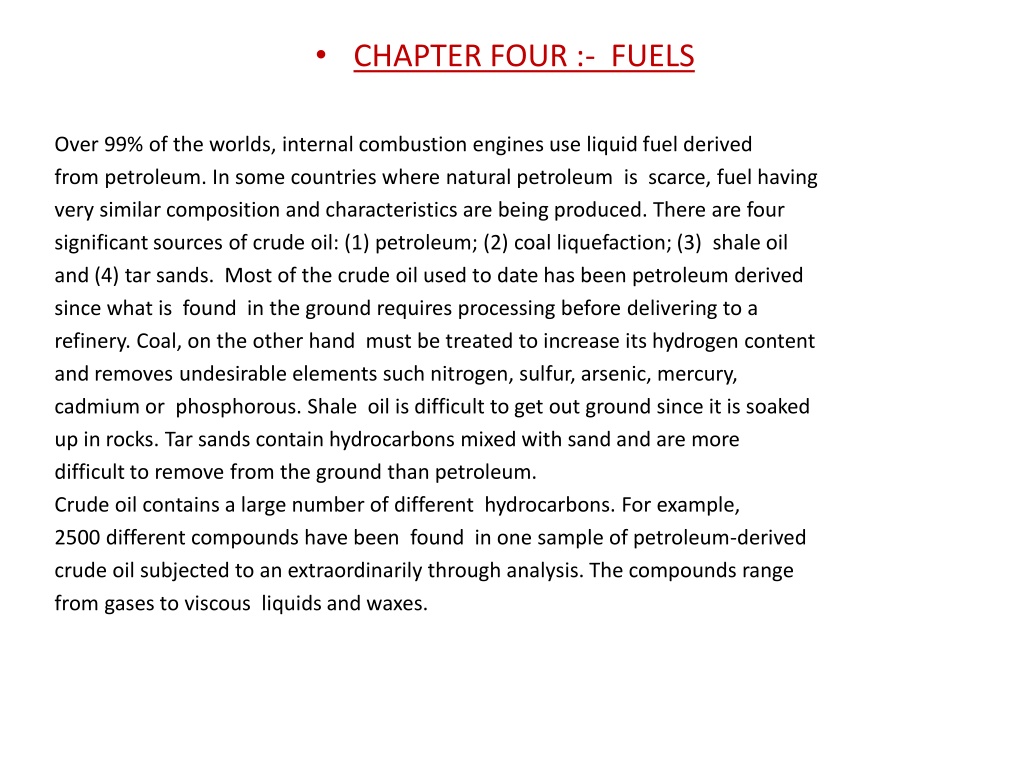Understanding Fuels and Their Sources
Fuels derived from petroleum, coal, shale oil, and tar sands are crucial for powering internal combustion engines. Crude oil contains various hydrocarbons requiring refining processes to obtain products like natural gas, gasoline, kerosene, diesel oils, fuel oils, and lubricating oils. The chemical structure of petrol fuel varies based on hydrocarbon groups.
Download Presentation

Please find below an Image/Link to download the presentation.
The content on the website is provided AS IS for your information and personal use only. It may not be sold, licensed, or shared on other websites without obtaining consent from the author. Download presentation by click this link. If you encounter any issues during the download, it is possible that the publisher has removed the file from their server.
E N D
Presentation Transcript
CHAPTER FOUR :- FUELS Over 99% of the worlds, internal combustion engines use liquid fuel derived from petroleum. In some countries where natural petroleum is scarce, fuel having very similar composition and characteristics are being produced. There are four significant sources of crude oil: (1) petroleum; (2) coal liquefaction; (3) shale oil and (4) tar sands. Most of the crude oil used to date has been petroleum derived since what is found in the ground requires processing before delivering to a refinery. Coal, on the other hand must be treated to increase its hydrogen content and removes undesirable elements such nitrogen, sulfur, arsenic, mercury, cadmium or phosphorous. Shale oil is difficult to get out ground since it is soaked up in rocks. Tar sands contain hydrocarbons mixed with sand and are more difficult to remove from the ground than petroleum. Crude oil contains a large number of different hydrocarbons. For example, 2500 different compounds have been found in one sample of petroleum-derived crude oil subjected to an extraordinarily through analysis. The compounds range from gases to viscous liquids and waxes.
Crude petroleum is a mixture of hydrocarbons compounds, small quantities of sulfur, small quantities of oxygen and nitrogen, small quantities of metallic compound such as iron, radium, nickel, etc. The exact composition of crude oil differs widely according to its source. Refining of crude oil usually starts with distillation at atmospheric pressure during which process of the distillate separated into various fractions according to volatility. The resulting distillates are called straight run products. Distillates may then be subjected to heat treatments and chemical treatments at various pressures and temperatures, such treatments are define as cracking, when they chiefly tend to reduce the average molecular size and as polymerization when the reverse predominates. The products resulting from the retirement are classified by their usage and according to their specific gravity and their volatility.
The important products of refining process are: 1) Natural gas: these gases are usually associated with liquid petroleum either standing above the liquid in the earth or dissolved in it. Some of these gases are methane, propane, butane et c. 2) Gasoline: this type is used in S.I.E; the chemical composition of its constituents varies widely depending on the base crude and the methods used in retiring. 3) Kerosene: it is used as a fuel in for C.I.E engines and aircraft gas turbines also as a jet fuel. Also, used in lamps, heaters etc. 4) Distillate: is slightly heavier than kerosene. 5) Diesel oils: are petroleum fractions that lie between kerosene and the lubricating oils. These oils cover a wide range of distillation having a wide range of specific gravity. They are used in various types of compression ignition engines. 6) Fuel oils: they are used in continuous burners. 7) Lubricating oils: they are made up in part from heavy distillates of petroleum and in part from residual oils, that is, oils remaining after distillation. 8) Tar, Asphalt and Petroleum coke are solid or semisolids products, which remain undistillated.
4.1 Chemical Structure of Petrol Fuel are often mixtures of hydrocarbons, the carbon and hydrogen atoms may be linked in different ways and these bonds or linked influence the chemical and physical properties of the different hydrocarbon groups. The following classifications cover the more important groups in petroleum fuels: 1) Straight Chain, or Normal Paraffins: the general chemical formula for this series is CnH2n+2 , where (n) is the number of carbon atoms. The carbon atoms are connected together as a chain with hydrogen atoms filling the empty valenus. For example; normal heptan (C7H16) H H H H H H H I I I I I I I H - C C C C C C C H I I I I I I I H H H H H H H
2-Branched Chain or Isoparaffins: the general formula is (CnH2n+2).In these compounds, the chain of carbon atoms is branched, for example isooctane (C8H18) H CH3 H CH3 H I I C --- C --- C --- C --- C --- H I I I H CH3 H H I I I H --- I I H
3-Olefins: are compounds with one ore more double bonded carbon atoms in a straight chain. The general formulas are: (1) for the mono-olefins (one double bonds) is: CnH2n for example; Hexane C6H12 (2) for the diolefins (two double bonds), for example; Butadiene (C4H6)and the general formulas are (CnH2n-2) H H H H H H H H H H H -- C -- C -- C -- C -- C == C -- H H -- C == C -- C == C -- H H H H H Butadiene Hexane .
4- Naphthenes: are characterized by a ring structure, examples the general formulas are (CnH2n) ,for example cyclopropane (C3H6 an) And cyclobutane (C4H8). 5- Aromatics: are hydrocarbons with carbon-carbon double bonds internal to a ring structure. The most common aromatic is benzene (C6H6.























